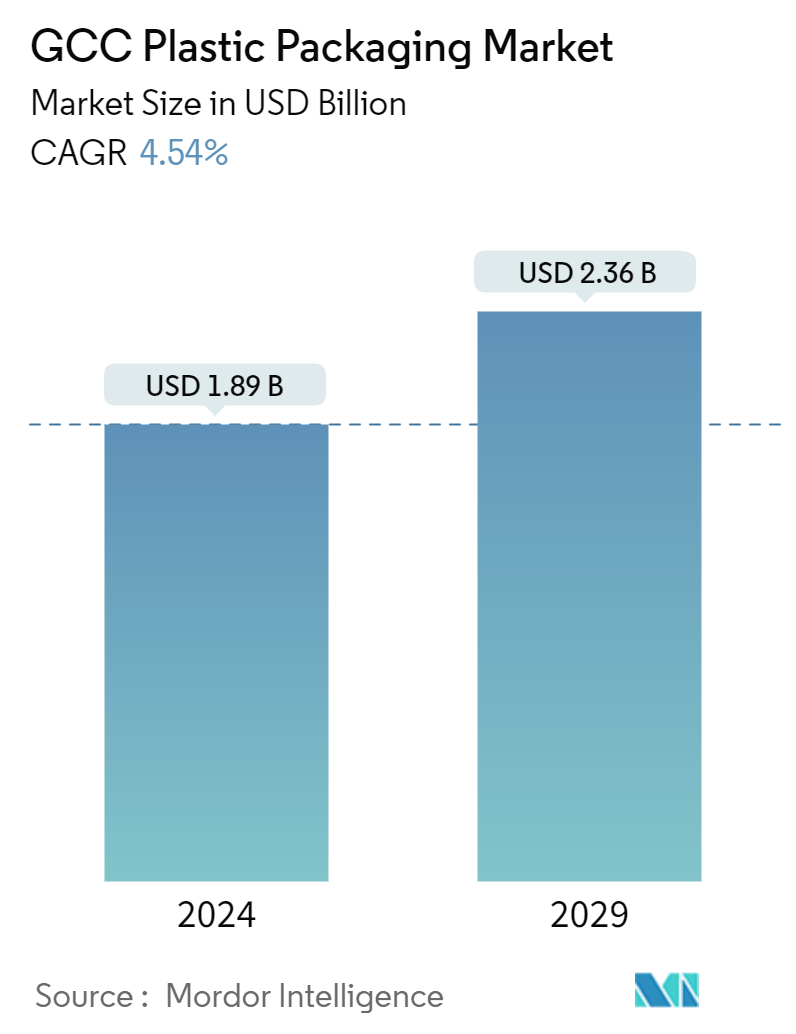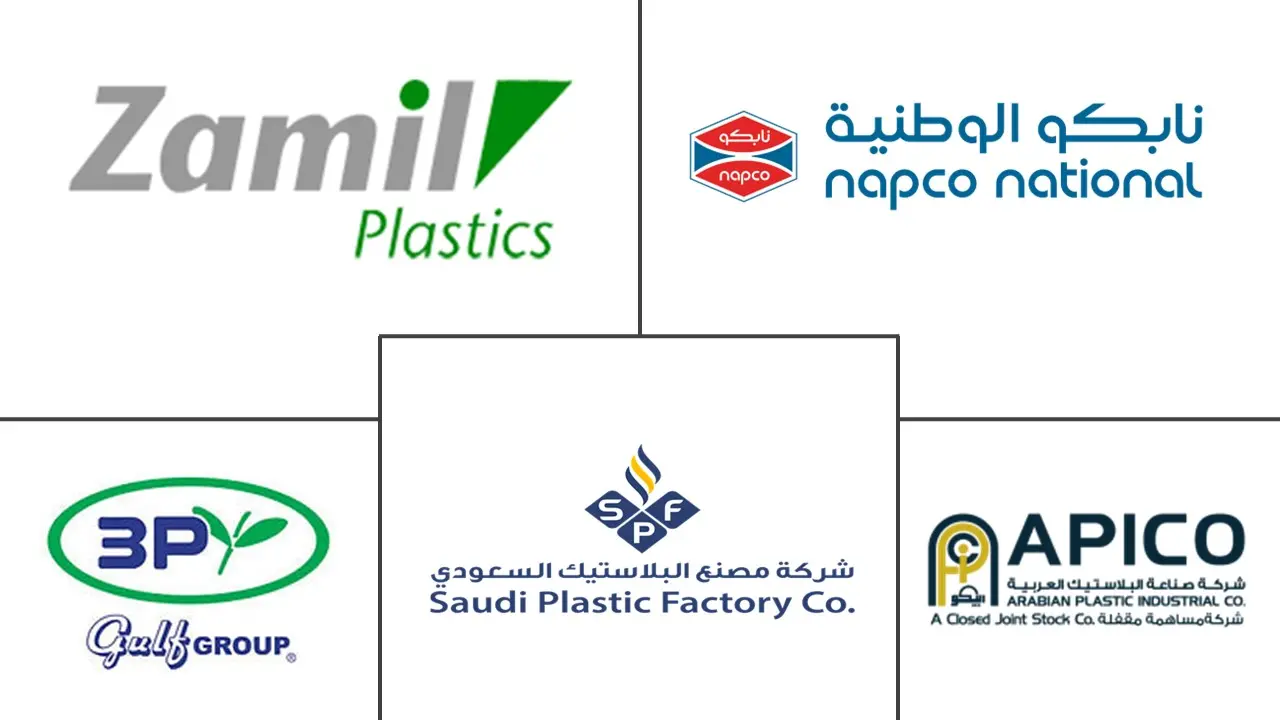Market Size of GCC Plastic Packaging Industry

| Study Period | 2019 - 2029 |
| Base Year For Estimation | 2023 |
| Market Size (2024) | USD 1.89 Billion |
| Market Size (2029) | USD 2.36 Billion |
| CAGR (2024 - 2029) | 4.54 % |
| Market Concentration | Low |
Major Players
*Disclaimer: Major Players sorted in no particular order |
GCC Plastic Packaging Market Analysis
The GCC Plastic Packaging Market size is estimated at USD 1.89 billion in 2024, and is expected to reach USD 2.36 billion by 2029, growing at a CAGR of 4.54% during the forecast period (2024-2029). In terms of production volume, the market is expected to grow from 1.68 thousand kilotons in 2024 to 2.06 thousand kilotons by 2029, at a CAGR of 4.13% during the forecast period (2024-2029).
- The plastics industry supports sustainability and the circular economy concept in various sectors by lowering regional dependence on scarce natural resources and achieving alignment with the GCC national visions of sustainable long-term growth. With a focus on the circular economy, up to 95% of plastic material value can be saved along its lifecycle. The drive toward a circular economy has accelerated rapidly in the last few years, with many regional companies adopting circular business models and innovation strategies to guarantee manufacturers access to more sustainable materials.
- In September 2023, the Gulf Petrochemicals and Chemicals Association (GPCA) and the GCC Accreditation Center (GAC) signed a Memorandum of Understanding (MoU). Their collaboration focuses on assessment and accreditation, aiming to foster sustainable solutions. These solutions aim to bolster the quality infrastructure within the Gulf Cooperation Council (GCC), encompassing nations like Saudi Arabia, Bahrain, Kuwait, Oman, Qatar, and the United Arab Emirates (UAE).
- The MoU will establish a framework to enhance the efficiency of conformity assessment processes in the region and guarantee that chemical and petrochemical products and processes meet specified standards and regulations. The agreement will also involve adopting a management to address the leakage of plastic waste into marine environments.
- The cosmetics and beauty industry in GCC countries is rapidly growing due to urbanization, demographic growth, and increasing consumer spending. Fueled by digitalization, the Gulf countries offer growth opportunities with the increasing online shopping trend among young consumers.
- The food industry in the GCC region recovered after the pandemic. The growing population, coupled with the increasing number of working professionals and a high proportion of expatriates, is a significant driver for the region’s food industry. Growing awareness of healthy eating habits of consumers in the region seeking high nutritional value has led to rising demand for fresh and organic food items. The use of plastic containers and pouches for food packaging, as pouches are low in weight and high in strength, drives the demand for plastic packaging.
- Plastic is one of the most used polymers in GCC as it can change and adapt its shape, offering opportunities for making bottles, pouches, bags, and other products. The availability of plastic substitutes essentially for packaging can hamper market growth. Consumers in GCC countries, particularly in Saudi Arabia and the United Arab Emirates, are increasingly becoming environmentally conscious owing to rising environmental concerns. This is influencing their purchase decisions regarding the materials used in product packaging.
- Plastic packaging is a crucial aspect in various end-use industries, including food and beverage, pharmaceutical, cosmetics, personal care, and industrial in the GCC region. Demand for sustainable packaging solutions produced from recycled or renewable sources in the region is an impactful way for manufacturers to promote eco-friendly solutions to customers.
GCC Plastic Packaging Industry Segmentation
The market is defined by the revenues accrued from the sales of flexible plastic packaging, i.e., the consumption of plastic packaging material and rigid plastic packaging in the GCC region. The study also considers the export-import dynamics of plastic packaging materials, the planned ban on plastic (including single-use plastics), and other relevant factors in the GCC region.
The GCC plastic packaging market is segmented by flexible plastic packaging (resin type [polyethylene (PE), polyethylene terephthalate (PET), polypropylene (PP), polystyrene (PS) and expanded polystyrene (EPS), polyvinyl chloride (PVC), and other resin types], product type [pouches, bag, films and wraps, and other product type], end-use industries [food, beverages, pharmaceuticals and healthcare, personal care and cosmetics, household care, and other end-use industries], country [Saudi Arabia, United Arab Emirates, and the Rest of GCC]), and rigid plastic packaging (resin type [polypropylene (PP), polyethylene terephthalate (PET), polyethylene (PE), polystyrene (PS) and expanded polystyrene (EPS), and other resin types], product type [bottles and jars, trays and containers, caps and closures, and other product type], end-use industry [food, foodservice, beverages, pharmaceuticals and healthcare, personal care and cosmetics, household care, and other end-user industries], country [Saudi Arabia, United Arab Emirates, and the Rest of GCC]). The report offers market forecasts and size in volume (units) and value (USD) for all the above segments.
GCC Plastic Packaging Market Size Summary
The GCC plastic packaging market is poised for significant growth, driven by the region's commitment to sustainability and the circular economy. This industry is integral to various sectors, including food and beverage, pharmaceuticals, cosmetics, and personal care, aligning with the GCC's national visions for sustainable development. The market is witnessing a shift towards circular business models, with companies adopting innovative strategies to enhance the sustainability of plastic materials. Collaborations, such as the MoU between the Gulf Petrochemicals and Chemicals Association and the GCC Accreditation Center, aim to bolster quality infrastructure and address environmental concerns, particularly plastic waste in marine environments. The demand for flexible plastic packaging is particularly strong in the food industry, fueled by urbanization, demographic changes, and a growing preference for convenient, on-the-go food options.
Saudi Arabia plays a pivotal role in the GCC plastic packaging market, with its economic activities heavily influenced by the oil and gas sector. The country's expanding food manufacturing sector, supported by a rising population and increasing consumer spending, is driving the demand for flexible plastic packaging. The market is characterized by a fragmented landscape with key players like Zamil Plastics Industries Inc., Napco National, and Saudi Plastic Factory Company leading the charge. Recent strategic moves, such as acquisitions and expansions, highlight the industry's focus on enhancing product offerings and gaining a competitive edge. Additionally, initiatives like the production of biodegradable polymers and the introduction of circular packaging projects underscore the region's commitment to sustainable and innovative packaging solutions.
GCC Plastic Packaging Market Size - Table of Contents
GCC Plastic Packaging Market Size FAQs
How big is the GCC Plastic Packaging Market?
The GCC Plastic Packaging Market size is expected to reach USD 1.89 billion in 2024 and grow at a CAGR of 4.54% to reach USD 2.36 billion by 2029.
What is the current GCC Plastic Packaging Market size?
In 2024, the GCC Plastic Packaging Market size is expected to reach USD 1.89 billion.

